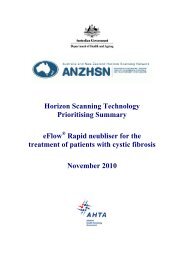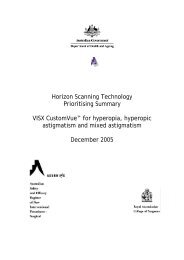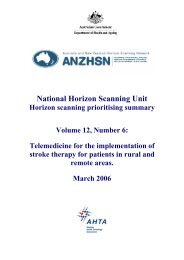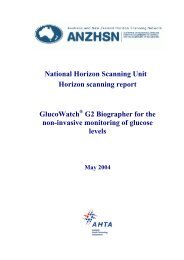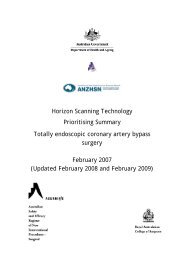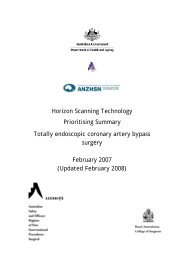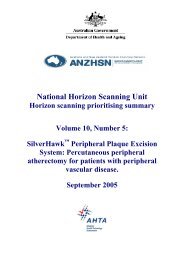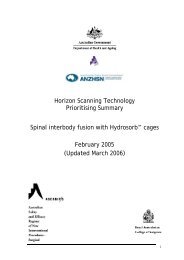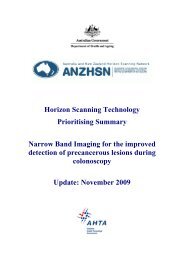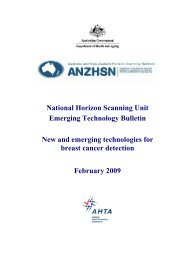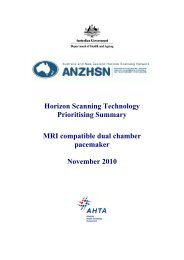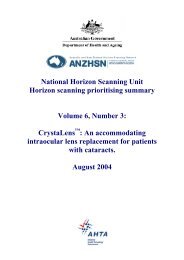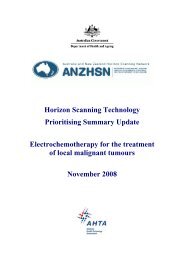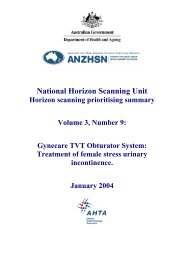Laser tissue welding using a protein-based solder for repair of blood ...
Laser tissue welding using a protein-based solder for repair of blood ...
Laser tissue welding using a protein-based solder for repair of blood ...
You also want an ePaper? Increase the reach of your titles
YUMPU automatically turns print PDFs into web optimized ePapers that Google loves.
Horizon Scanning Technology<br />
Prioritising Summary<br />
<strong>Laser</strong> <strong>tissue</strong> <strong>welding</strong> <strong>using</strong> a <strong>protein</strong>-<strong>based</strong><br />
<strong>solder</strong><br />
April 2004<br />
April 2004 1
© Commonwealth <strong>of</strong> Australia [2004]<br />
This work is copyright. You may download, display, print and reproduce this material in<br />
unaltered <strong>for</strong>m only (retaining this notice) <strong>for</strong> your personal, non-commercial use or use<br />
within your organisation. Apart from any use as permitted under the Copyright Act 1968,<br />
all other rights are reserved. Requests and inquiries concerning reproduction and rights<br />
should be addressed to Commonwealth Copyright Administration, Attorney General’s<br />
Department, Robert Garran Offices, National Circuit, Canberra ACT 2600 or posted at<br />
http://www.ag.gov.au/cca<br />
Electronic copies can be obtained from http://www.horizonscanning.gov.au<br />
Enquiries about the content <strong>of</strong> the report should be directed to:<br />
HealthPACT Secretariat<br />
Department <strong>of</strong> Health and Ageing<br />
MDP 106<br />
GPO Box 9848<br />
Canberra ACT 2606<br />
AUSTRALIA<br />
DISCLAIMER: This report is <strong>based</strong> on in<strong>for</strong>mation available at the time <strong>of</strong> research and<br />
cannot be expected to cover any developments arising from subsequent improvements to<br />
health technologies. This report is <strong>based</strong> on a limited literature search and is not a<br />
definitive statement on the safety, effectiveness or cost-effectiveness <strong>of</strong> the health<br />
technology covered.<br />
The Commonwealth does not guarantee the accuracy, currency or completeness <strong>of</strong> the<br />
in<strong>for</strong>mation in this report. This report is not intended to be used as medical advice and it<br />
is not intended to be used to diagnose, treat, cure or prevent any disease, nor should it be<br />
used <strong>for</strong> therapeutic purposes or as a substitute <strong>for</strong> a health pr<strong>of</strong>essional's advice. The<br />
Commonwealth does not accept any liability <strong>for</strong> any injury, loss or damage incurred by<br />
use <strong>of</strong> or reliance on the in<strong>for</strong>mation.<br />
The production <strong>of</strong> this Horizon scanning prioritising summary was overseen by the<br />
Health Policy Advisory Committee on Technology (HealthPACT), a sub-committee <strong>of</strong><br />
the Medical Services Advisory Committee (MSAC). HealthPACT comprises<br />
representatives from health departments in all states and territories, the Australia and<br />
New Zealand governments; MSAC and ASERNIP-S. The Australian Health Ministers’<br />
Advisory Council (AHMAC) supports HealthPACT through funding.<br />
This Horizon scanning prioritising summary was prepared by staff from the Australian<br />
safety and Efficacy Register <strong>of</strong> New Interventional Procedures – Surgical (ASERNIP-S).<br />
April 2004 2
NAME OF TECHNOLOGY:<br />
<strong>Laser</strong> <strong>tissue</strong> <strong>welding</strong> <strong>using</strong> <strong>protein</strong>-<strong>based</strong> <strong>solder</strong>.<br />
PURPOSE & TARGET GROUP:<br />
This procedure enables the <strong>repair</strong> <strong>of</strong> vessels without sutures. There<strong>for</strong>e, it may be widely<br />
applicable, especially in ophthalmology, urology and vascular surgery.<br />
STAGE OF DEVELOPMENT (IN AUSTRALIA):<br />
<br />
<br />
<br />
<br />
<br />
<br />
Experimental<br />
Investigational<br />
Nearly Established<br />
Established<br />
Established but changed indication or modification <strong>of</strong> technique<br />
Should be taken out <strong>of</strong> use<br />
No device is listed or registered in the Australian Register <strong>of</strong> Therapeutic Goods that is<br />
capable <strong>of</strong> functioning as a <strong>protein</strong>-<strong>based</strong> <strong>solder</strong>.<br />
INTERNATIONAL UTILISATION:<br />
COUNTRY<br />
USA<br />
LEVEL OF USE<br />
Trials underway Limited use Widely Diffused<br />
<br />
IMPACT SUMMARY<br />
Background:<br />
Sutures are predominantly utilised <strong>for</strong> procedures requiring the joining <strong>of</strong> two vessel<br />
ends. 1 The new process <strong>of</strong> laser <strong>tissue</strong> <strong>welding</strong>, <strong>using</strong> a <strong>protein</strong>-<strong>based</strong> <strong>solder</strong>, joins vessel<br />
ends without requiring sutures, resulting in “sutureless surgery”.<br />
The human albumin–<strong>based</strong> <strong>solder</strong> incorporates indocyanine green dye resulting in an<br />
optimal absorption <strong>of</strong> laser wavelength <strong>of</strong> approximately 810nm, effectively f<strong>using</strong> the<br />
outer edges <strong>of</strong> the wound surface without penetrating to deep <strong>tissue</strong>. 2<br />
It has been shown that laser <strong>welding</strong> is a quick, reliable method <strong>for</strong> the <strong>repair</strong> <strong>of</strong> <strong>blood</strong><br />
vessels. The <strong>protein</strong>-<strong>based</strong> <strong>solder</strong> utilised <strong>for</strong> this procedure is not only resorbable, but is<br />
thought to eventually provide a tensile strength greater than that <strong>of</strong> normal sutures, and to<br />
have a lower complication rate than traditional suturing. 3<br />
Clinical need and burden <strong>of</strong> disease:<br />
Suturing has several detrimental aspects; the penetrating needle can induce vascular wall<br />
damage, and the non-absorbable suture material can cause an inflammatory response. An<br />
April 2004 3
inflammatory response can also lead to thrombocyte aggregation or intimal hyperplasia,<br />
resulting in stenosis. 1<br />
Estimated speed, geographic and practitioner use patterns <strong>of</strong> diffusion in<br />
the health system:<br />
Kirsch and colleagues first published phase I clinical trial results <strong>of</strong> laser <strong>tissue</strong> <strong>welding</strong><br />
<strong>using</strong> a <strong>protein</strong>-<strong>based</strong> <strong>solder</strong> in August 1995, with results from a comparative study<br />
published in 1997. The Australian Federal Government has donated $250,000 <strong>for</strong> the<br />
development <strong>of</strong> a similar Australian product by Avastra, which will commence clinical<br />
trials early 2004, under the direction <strong>of</strong> Dr Peter Maitz. 5<br />
Existing comparators:<br />
Traditional nylon sutures<br />
Estimated cost impact:<br />
The costs associated with this new product are not available. The cost <strong>of</strong> traditional<br />
suturing <strong>repair</strong> in Australia is also not available. However, the reimbursement cost as<br />
stated by the Medicare Benefits Schedule <strong>for</strong> the traditional <strong>repair</strong> <strong>using</strong> microsurgical<br />
techniques, <strong>for</strong> restoration <strong>of</strong> continuity <strong>of</strong> artery or vein is estimated to be approximately<br />
$906. 6<br />
Efficacy and safety issues:<br />
Short-term safety and efficacy data exist from two non randomised comparative studies<br />
(evidence level III-2) 7 and one case series (evidence level IV) 7 . Most studies were<br />
conducted <strong>using</strong> a <strong>protein</strong>-<strong>based</strong> <strong>solder</strong> containing human albumin concentrations <strong>of</strong><br />
approximately 50%, which has been shown to achieve optimal tensile strength. 8<br />
Study details Key efficacy findings Key safety findings<br />
Comparative study<br />
Kirsch et al. 2 1997, USA<br />
36 Patients<br />
Follow up: 3 months to 3 years<br />
<strong>Laser</strong> Tissue Welding (LTW)<br />
(n=25)<br />
Suture group (n=11)<br />
Selection Criteria:<br />
Urethral Surgery<br />
No strictures or diverticule<br />
resulted in suture or LTW groups.<br />
No patients in suture or LTW<br />
groups experienced wound<br />
infection or poor wound healing.<br />
Kirsch et al. 4 2001, USA<br />
138 Patients<br />
Age range: 6 months to 34 years,<br />
mean 15 months<br />
Follow up: Mean 12 months (min<br />
6 months, max 22 months)<br />
<strong>Laser</strong> <strong>tissue</strong> <strong>welding</strong> (LTW)<br />
(n=54)<br />
Suture (n=84)<br />
Selection Criteria:<br />
Mean operating times were<br />
significantly shorter in LTW<br />
(mean 5.1±0.3 (SD)min)<br />
compared<br />
with suture group (mean 26.7±1.7<br />
(SD) min) (P
Hypospadias <strong>repair</strong><br />
Case Series<br />
Kirsch et al. 3 1995, USA<br />
10 Patients<br />
Age range: 3 months to 38 years,<br />
mean 8 years.<br />
Follow Up: mean 7.1±2.2 months<br />
<strong>Laser</strong> <strong>tissue</strong> <strong>solder</strong>ing (LTW)<br />
Selection Criteria:<br />
Urinary tract reconstruction<br />
(SD)) compared with the suture<br />
group (mean 23.2±1.5(SD))<br />
(P
3. Kirsch AJ, Miller MI, Hensle TW, Chang DT, Shabsigh R, Olsson CA, Connor JP.<br />
<strong>Laser</strong> <strong>tissue</strong> <strong>solder</strong>ing in urinary tract reconstruction: first human experience. Urology<br />
1995;46(2):261-6.<br />
4. Kirsch AJ, Cooper CS, Gatti J, Scherz HC, Canning DA, Zderic SA, Snyder HM 3 rd .<br />
<strong>Laser</strong> <strong>tissue</strong> <strong>solder</strong>ing <strong>for</strong> hypospadias <strong>repair</strong>: results <strong>of</strong> a controlled prospective clinical<br />
trial. Journal <strong>of</strong> Urology 2001;165(2):574-7.<br />
5. Doctors set to remove need <strong>for</strong> a stitch in time<br />
http://www.abc.net.au/news/health/sophie-scott/newsitems/s994839.htm Accessed<br />
December 2003.<br />
6. Medicare Benefits Schedule – item 45500.<br />
http://www.health.gov.au/pubs/mbs/mbs6/cat3gro6.htm#Items-45500 Accessed January<br />
2004.<br />
7. Designation <strong>of</strong> level <strong>of</strong> evidence. How to use the evidence: assessment and<br />
application <strong>of</strong> scientific evidence, pp8. Canberra: NHMRC.2000.<br />
8. Bloom JN, Duffy MT, Davis JB, McNally-Heintzelman KM. A light-activated<br />
surgical adhesive technique <strong>for</strong> sutureless ophthalmic surgery. Architectural<br />
Ophthalmology 2003 Nov;121(11):1591-5.<br />
SOURCES OF FURTHER INFORMATION:<br />
Maitz PK, Trickett RI, Dekker P, Tos P, Dawes JM Piper JA, Lanzetta M, Owen ER.<br />
Sutureless microvascular anastomoses by a biodegradable laser-activated solid <strong>protein</strong><br />
<strong>solder</strong>. Plastic Reconstructive Surgery 1999 Nov; 104(6):1726-31.<br />
SEARCH CRITERIA:<br />
A search <strong>of</strong> MEDLINE, PubMed and Cochrane Library, Current Controlled Trials<br />
metaRegister, UK National Research Register International, Network <strong>for</strong> Agencies <strong>for</strong><br />
Health Technology Assessments, relevant online journals and the Internet was conducted<br />
in January 2004.<br />
Search terms used were: ‘<strong>tissue</strong> <strong>welding</strong>’, ‘<strong>protein</strong> <strong>solder</strong> and <strong>tissue</strong> <strong>welding</strong>’, ‘laser<br />
<strong>welding</strong>’ and ‘sutureless surgery’<br />
April 2004 6



